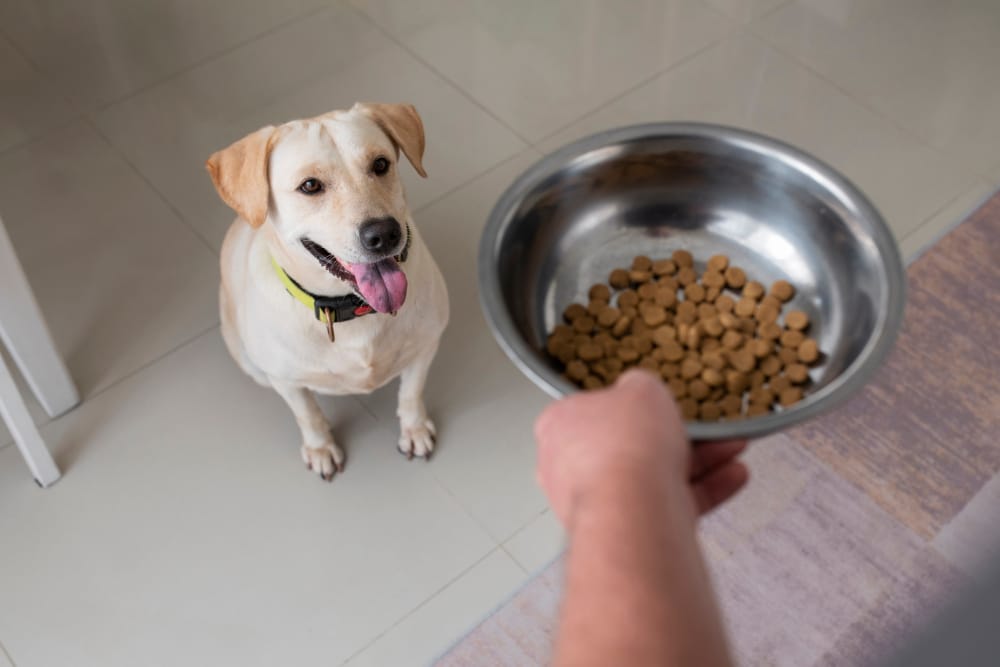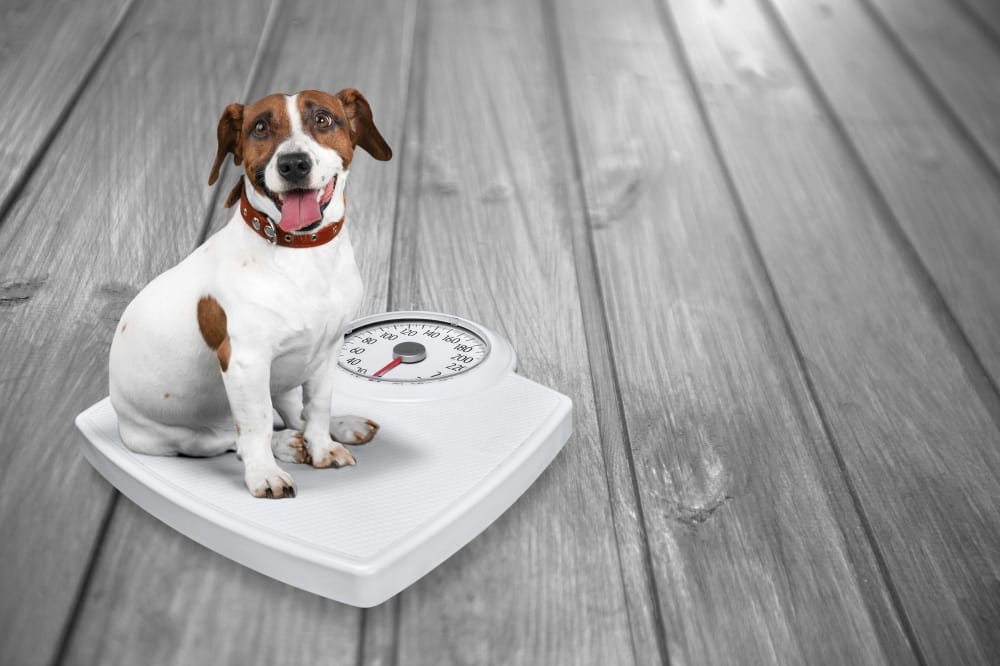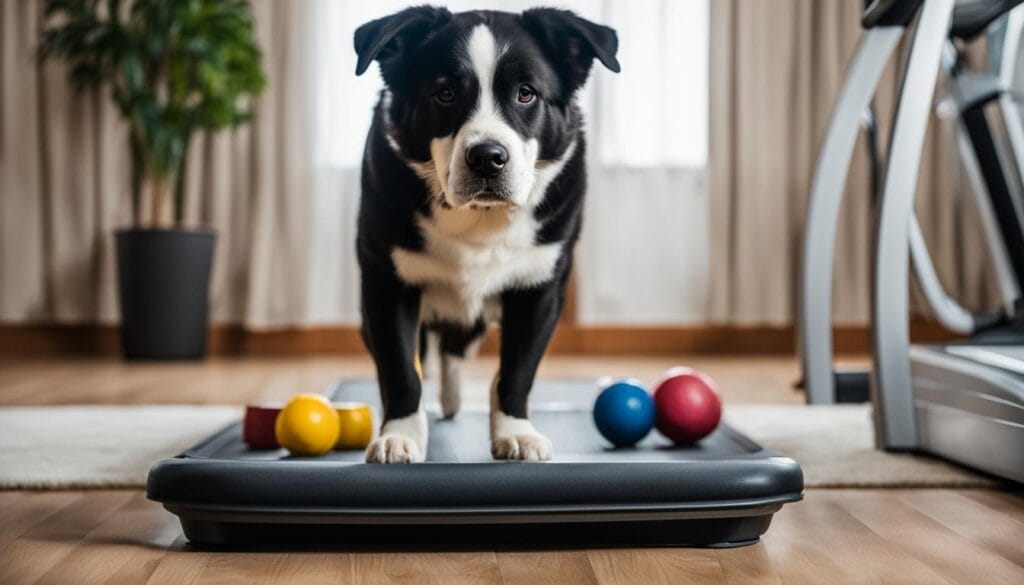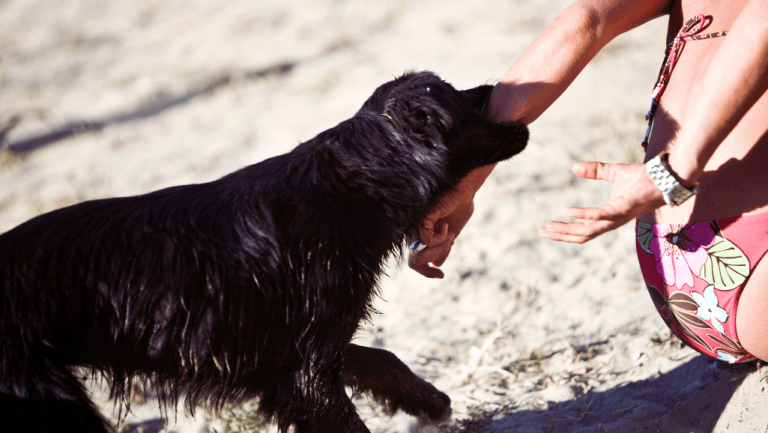Obesity is a serious issue for dogs, posing significant health risks such as diabetes, heart disease, arthritis, and cancer. It is essential to proactively manage your dog’s weight through proper diet and exercise to ensure their overall well-being and longevity. In this article, we will provide you with information and tips on obesity and weight management for your dogs.
Key Takeaways:
- Obesity in dogs can lead to diabetes, heart disease, arthritis, and cancer.
- Managing your dog’s weight through diet and exercise is crucial for their well-being.
- Consulting with a veterinarian is essential to create an effective weight loss program.
- Diet plans tailored to your dog’s needs can help achieve a safe weight loss.
- Regular exercise plays a vital role in Dog Weight Management.
Why Should My Dog Lose Weight?
Dogs that are overweight or obese are at a higher risk for developing serious medical conditions. These conditions include type 2 diabetes, heart disease, osteoarthritis, joint injuries, high blood pressure, and certain forms of cancer. It is important to address your dog’s weight issue to prevent or manage these health risks.
Medical Conditions Associated with Excess Weight
Excess weight in dogs can significantly impact their health and well-being. Here are some medical conditions commonly associated with obesity:
| Medical Condition | Description |
|---|---|
| Type 2 Diabetes | Obesity can lead to insulin resistance and an increased risk of developing diabetes in dogs. |
| Heart Disease | Excess weight puts strain on the heart, increasing the risk of heart-related issues and decreased lifespan. |
| Osteoarthritis | The additional weight adds pressure to the joints, causing pain, inflammation, and reduced mobility. |
| Joint Injuries | Overweight dogs are more prone to musculoskeletal injuries, such as ligament tears and joint dislocations. |
| High Blood Pressure | Excess weight can elevate blood pressure, leading to cardiovascular problems and organ damage. |
| Certain Forms of Cancer | Obesity is associated with a higher risk of developing various types of cancer in dogs. |
How Should I Begin a Weight Loss Program for My Dog?
Starting a weight loss program for your dog requires careful consideration and professional guidance. Before implementing any changes to your dog’s diet or exercise routine, it is crucial to consult with a veterinarian experienced in weight management for pets. Veterinary assistance is essential to ensure a safe and effective weight loss program tailored to your dog’s specific needs.
To begin the weight loss journey, your veterinarian will conduct a thorough physical examination of your dog. This examination helps determine your dog’s current health status and identify any underlying medical conditions that may be contributing to the weight issue. It is important to rule out these underlying medical conditions before proceeding with a weight loss program.
In some cases, your veterinarian may also recommend blood tests to gain further insights into your dog’s overall health and identify any potential issues that may affect the weight loss program. By assessing your dog’s blood profile, the veterinarian can gather valuable information to develop a comprehensive weight loss plan.
Veterinary assistance is invaluable in establishing a weight loss program that suits your dog’s specific needs. A customized plan takes into account factors such as breed, age, underlying health conditions, and lifestyle. With professional guidance, you can rest assured knowing that the weight loss program is safe, effective, and aligned with your dog’s overall well-being.
How Much Should I Feed My Dog to Promote Weight Loss?
Proper portion control is essential when feeding your dog to promote weight loss. Your veterinarian will calculate your dog’s ideal weight based on its breed and size. They may recommend a target weight higher than the ideal weight to start, depending on the degree of excess weight.
A safe weight loss for most dogs is 3-5% of their body weight per month. This gradual approach ensures a healthy and sustainable weight loss journey. Caloric intake should be adjusted accordingly to achieve this desired weight loss rate.
Portion control plays a crucial role in successful weight loss for dogs. By carefully measuring and controlling the amount of food you feed your dog, you can help them achieve their ideal weight. It is important to follow your veterinarian’s recommendations and guidelines for portion sizes and feeding frequency.
Here are some guidelines for portion control:
- Measure your dog’s food using a kitchen scale or measuring cup to ensure accuracy.
- Avoid free-feeding or leaving food out all day. Instead, feed your dog specific meals at designated times.
- Divide the recommended daily food amount into multiple smaller meals to help your dog feel satisfied throughout the day.
Remember, each dog is unique, and their calorie requirements may vary. It is important to consult with your veterinarian to determine the appropriate portion sizes and feeding schedule for your dog’s weight loss goals. Regular monitoring of your dog’s weight and progress is also essential to make any necessary adjustments to their diet plan.
By implementing portion control and following your veterinarian’s guidance, you can help your dog achieve a healthy weight and improve their overall well-being.
What Makes Veterinary Weight Loss Diets Special?
When it comes to weight loss diets for dogs, veterinary formulated diets stand out for their effectiveness. These specialized diets are particularly beneficial for dogs that require significant weight loss or have other medical conditions. Veterinary weight loss diets are carefully designed to provide specific nutrients and follow specific composition guidelines to promote successful weight loss and overall well-being.
One of the key factors that make veterinary weight loss diets special is their high protein content. Protein is essential for maintaining and building lean muscle mass, which is crucial during weight loss. High protein diets can help dogs feel more satisfied and prevent muscle loss while shedding excess pounds.
In addition to high protein, these diets are often low in carbohydrates. Dogs do not have the same dietary requirements for carbohydrates as humans do, and excessive consumption of carbohydrates can lead to weight gain. By reducing carbohydrate intake and increasing protein levels, veterinary weight loss diets can help dogs maintain a healthy weight.
Furthermore, veterinary weight loss diets are often high in fiber. Fiber plays a crucial role in promoting satiety and reducing begging behavior. It helps dogs feel full and satisfied, preventing excessive hunger and the desire to overeat. Additionally, a high fiber diet can aid in digestion and regulate bowel movements, promoting overall gastrointestinal health.
Veterinary Weight Loss Diets: Key Features
- High protein content to preserve lean muscle mass
- Low carbohydrate levels to prevent weight gain
- High fiber content to promote satiety and regulate digestion
- Specific nutrient formulations to enhance metabolism
Your veterinarian is best equipped to recommend the most suitable weight loss diet for your dog based on their specific needs. They can assess your dog’s current health, weight, and medical conditions to determine the most effective dietary plan. By following a veterinary weight loss diet, your dog can achieve their weight loss goals while maintaining optimal nutrition and overall health.
“Using a veterinarian-formulated weight loss diet can help dogs achieve their weight loss goals while ensuring they receive the necessary nutrients for optimal health.”
How Quickly Should I Introduce the New Diet to My Dog?
When transitioning your dog to a new diet, it is important to make the change gradually over the course of a week. This gradual transition helps minimize digestive upsets and allows your dog to adjust to the new taste and texture of the food.
Start by mixing a small amount of the new diet with their current food, gradually increasing the proportion of the new diet each day. This gradual change gives your dog’s digestive system time to adapt and reduces the likelihood of any gastrointestinal upset.
Additionally, enhancing the palatability of the new diet can encourage your dog to accept it more readily. Flavorings like salmon juice or low-fat broth can be added to the food to make it more appealing and enjoyable for your dog.
When selecting a new diet for weight loss, it is crucial to consider the calorie content. Look for specific weight loss formulas that are designed to help dogs shed pounds. The calorie content information can be found on the food label or obtained from the manufacturer.
Expert Tip:
“A slow and gradual transition is key when introducing a new diet to your dog. This allows their digestive system to adjust and helps prevent any digestive upsets. Adding flavorings to the food can also make it more enticing for your dog.”
To give you a visual representation of the recommended diet transition process, here’s a table outlining the gradual change over the course of a week:
| Day | Mixture |
|---|---|
| Day 1 | 75% old diet 25% new diet |
| Day 2 | 50% old diet 50% new diet |
| Day 3 | 25% old diet 75% new diet |
| Day 4 | 100% new diet |
The gradual transition outlined in the table gives your dog time to adjust to the new diet while minimizing any digestive issues. Remember to monitor your dog’s response during the transition and consult your veterinarian if you have any concerns or questions.
How Can I Get My Dog to Lose More Weight Through Exercise?
Exercise plays a crucial role in weight loss for dogs. By incorporating physical activities into your dog’s daily routine, you can help them burn calories and improve their overall fitness. Here are some effective strategies to help your dog shed those extra pounds:
1. Daily Walks
A daily walk is a simple yet effective exercise for weight loss. Increase the intensity and length of your dog’s walks gradually to help them burn more calories. This not only aids in weight loss but also promotes cardiovascular health and strengthens muscles.
2. Increased Intensity
Aside from longer walks, consider adding some interval training to your dog’s exercise routine. This involves incorporating short bursts of increased intensity, such as jogging or running, followed by brief periods of rest. Interval training can help boost calorie burn and contribute to weight loss.
3. Playtime
Engage your dog in regular play sessions to encourage physical activity and weight loss. Use interactive toys, such as puzzle toys or treat-dispensing toys, to keep your dog mentally stimulated while they exercise. This helps burn calories and prevents boredom.
4. Interactive Toys
Interactive toys are a great way to keep your dog active and help them shed pounds. Toys that require physical activity, such as rope toys for tug-of-war or balls for fetch, can provide a fun and engaging workout. Regular playtime with interactive toys ensures that your dog stays active and burns calories.
“Regular exercise is key to helping your dog lose weight and maintain a healthy lifestyle. By implementing these strategies, you can make exercise a fun and effective part of your dog’s weight loss journey.”
Remember to monitor your dog’s response to exercise and make adjustments as needed. Gradually increase the intensity and duration of exercise sessions to prevent overexertion or fatigue. Always prioritize your dog’s safety and well-being while encouraging weight loss through exercise.
How Often Should I Have My Dog’s Progress Checked?
Regular progress checks are crucial for monitoring the effectiveness of your dog’s weight loss program. By conducting regular weight checks, you can track your dog’s progress towards achieving their ideal weight. It is recommended to weigh your dog every month until the target weight is reached. This allows you to assess the rate of weight loss and make any necessary adjustments to the program.
If, after a month of following the weight loss program, there is no significant weight loss observed, it may be necessary to modify or adjust the program. Consulting with your veterinarian is essential during this process as they can provide professional guidance based on your dog’s individual needs. They may recommend changes to the diet plan, exercise routine, or suggest additional monitoring and interventions to ensure successful weight loss.
Monthly Progress Check: Ideal Weight
During the monthly progress check, it is essential to measure your dog’s weight accurately. Here is a simple table to help you record and track your dog’s weight loss progress:
| Month | Weight (lbs) |
|---|---|
| Month 1 | 85 |
| Month 2 | 82 |
| Month 3 | 78 |
| Month 4 | 76 |
In the example above, you can see a steady decrease in weight over the course of four months. If your dog’s weight loss is not progressing as expected, it may be time to consult with your veterinarian and explore possible reasons for the lack of progress. They can assess your dog’s overall health and make adjustments to the weight loss program accordingly.
Remember, weight loss is a journey that requires ongoing monitoring and program modification. With the guidance of your veterinarian and consistent progress checks, you can help your dog achieve and maintain a healthy weight for a long, happy, and active life.
When My Dog is Hungry, She Pesters Me. Any Suggestions?
Dogs that beg for food can be challenging to manage during a weight loss program. It’s important to address this behavior and find alternative ways to satisfy your dog’s hunger without derailing their progress. Here are some suggestions to help you manage this common issue:
- Avoid using self-feeders: Self-feeders make it difficult to control portion sizes and can lead to overeating. Instead, measure your dog’s meals accurately to ensure they are getting the right amount of food.
- Provide alternative activities: When your dog starts pestering you for food, redirect their attention to other activities. Spend some quality time petting them, engage in playtime with their favorite toys, or take them for a walk.
- Feeding small, frequent meals: Consider dividing your dog’s daily food allowance into smaller, more frequent meals. This can help satisfy their hunger throughout the day and reduce the urge to beg.
- Food puzzles: Food puzzles are a great way to keep your dog mentally stimulated while slowing down their eating. These puzzles require your dog to work for their food, providing both entertainment and a sense of fulfillment.
By implementing these suggestions, you can help manage your dog’s food begging behavior and keep them on track with their weight loss journey.
| Pros | Cons |
|---|---|
| Helps control portion sizes | May require additional time and effort |
| Provides alternative forms of stimulation | Initial resistance and adjustment period for your dog |
| Reduces the likelihood of overeating | Requires consistency and perseverance |
| Can help satisfy your dog’s hunger | May not completely eliminate food begging behavior |
What Are the Health Risks for Overweight Pets?
Pet obesity can have severe consequences on your furry friend’s health and well-being. Overweight and obese pets are more vulnerable to a range of diseases and conditions that can significantly impact their quality of life. Here are some of the health risks associated with pet obesity:
- Osteoarthritis: Excess weight puts additional strain on your pet’s joints, leading to pain, stiffness, and reduced mobility.
- Diabetes: Obesity increases the risk of developing diabetes, a condition that requires lifelong management and can lead to other complications.
- Respiratory and heart diseases: Being overweight puts stress on the heart and lungs, making your pet more susceptible to respiratory ailments and cardiovascular issues.
- Kidney disease: Obesity can contribute to the development of kidney problems, which can have significant consequences for your pet’s overall health.
- High blood pressure: Just like in humans, excess weight can lead to hypertension in pets, increasing the risk of heart disease and other related illnesses.
- Certain forms of cancer: Research suggests a link between obesity and an increased risk of cancer in pets, particularly mammary and bladder cancer.
These health conditions can cause chronic pain and inflammation, reducing your pet’s overall quality of life and potentially shortening their lifespan. It is crucial to manage your pet’s weight to mitigate these risks and promote their well-being.
“Overweight and obese pets are more vulnerable to a range of diseases and conditions that can significantly impact their quality of life.”
Proper diet and exercise are key to managing your pet’s weight and reducing the associated health risks. Consult with your veterinarian to develop a tailored weight loss plan that includes a balanced diet, portion control, and regular exercise. By taking proactive steps, you can help your pet achieve a healthier weight and improve their overall health and vitality.
What Commonly Causes Obesity in Pets?
Pets can become overweight due to a combination of factors, including excessive calorie consumption and lack of exercise. These causes are prevalent among pets of all breeds and sizes. However, certain high-risk breeds, such as Labrador retrievers, pugs, and beagles, are more prone to obesity than others.
Let’s take a closer look at the primary causes of pet obesity:
- Excessive Calorie Consumption: Overfeeding or a diet that is high in calorie-dense foods can contribute to pet obesity. Treats and table scraps can also add up, leading to weight gain.
- Lack of Exercise: Sedentary lifestyles and insufficient physical activity can result in weight gain. Dogs and cats require regular exercise to burn calories and maintain a healthy weight.
If you have a pet from a high-risk breed, it’s important to be extra vigilant in monitoring their diet, exercise, and weight. By taking proactive measures to manage their weight, you can help reduce the risk of obesity-related health issues and improve their overall well-being.
Next, we will explore how to start a weight loss program for your pet and the importance of veterinary assistance in achieving successful weight management.
Conclusion
Obesity is a prevalent issue in dogs that can have serious health consequences. However, with the right approach to weight management, you can improve your dog’s overall health and well-being. Implementing appropriate diet plans, exercise routines, and seeking veterinary assistance are essential steps in tackling obesity in dogs.
By providing your dog with a balanced and calorie-controlled diet, you can help them achieve and maintain a healthy weight. Regular exercise, such as daily walks and interactive playtime, not only burns calories but also improves their fitness and mental stimulation. Additionally, consulting with a veterinarian is crucial to ensure that your dog’s weight loss program is safe and effective.
Veterinary professionals can help rule out any underlying medical conditions that may contribute to your dog’s weight gain and provide tailored advice to meet your dog’s specific needs. Remember, managing your dog’s weight is about more than just physical appearance – it plays a vital role in preventing or managing diseases, increasing their lifespan, and enhancing their overall quality of life. Take the necessary steps today to help your furry friend achieve and maintain a healthy weight!




















